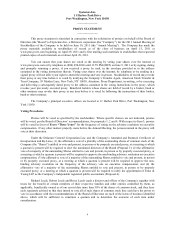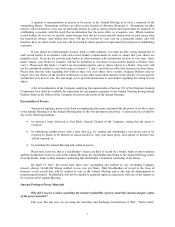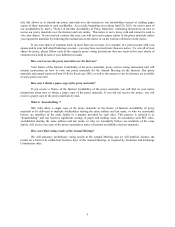CompUSA 2010 Annual Report Download - page 19
Download and view the complete annual report
Please find page 19 of the 2010 CompUSA annual report below. You can navigate through the pages in the report by either clicking on the pages listed below, or by using the keyword search tool below to find specific information within the annual report.16
sessions. Following an executive session of independent directors, the Lead Independent Director acts as a liaison
between the independent directors and the Chairman regarding any specific feedback or issues, provides the
Chairman with input regarding agenda items for Board and Committee meetings, and coordinates with the Chairman
regarding information to be provided to the independent directors in performing their duties. The Board believes that
this approach appropriately and effectively complements the combined CEO/Chairman structure.
We recognize that different board leadership structures may be appropriate for companies in different
situations and believe that no one structure is suitable for all companies. We believe our current Board leadership
structure is optimal for us because it demonstrates to our employees, suppliers, customers, and other stakeholders
that the Company is under strong leadership, with a single person setting the tone and having primary responsibility
for managing our operations. Having a single leader for both the Company and the Board eliminates the potential for
confusion or duplication of efforts, and provides clear leadership for the Company. We believe the Company, like
many U.S. companies, has been well-served by this leadership structure.
Lead Independent Director
The independent Directors elect one independent Director to serve as a Lead Independent Director. In
addition to presiding at executive sessions of nonemployee Directors, the Lead Independent Director has the
responsibility to coordinate the activities of the independent Directors, and to perform the following functions: (a)
advise the Chairman of the Board as to an appropriate schedule of Board meetings, seeking to ensure that the
independent Directors can perform their duties responsibly while not interfering with the flow of the Company’ s
operations; (b) provide the Chairman with input as to the preparation of agendas for the Board and committee
meetings; (c) advise the Chairman as to the quality, quantity, and timeliness of the flow of information from the
Company’ s management that is necessary for the independent directors to effectively and responsibly perform their
duties, and although the Company’ s management is responsible for the preparation of materials for the Board, the
Lead Independent Director may specifically request the inclusion of certain material; (d) recommend to the
Chairman the retention of consultants who report directly to the Board; (e) assist the Board and the Company’ s
officers in assuring compliance with and implementation of the corporate governance policies; and be principally
responsible for recommending revisions to the corporate governance policies; (f) coordinate and develop the agenda
for, and moderate executive sessions of, the independent directors of the Board, and act as principal liaison between
the independent directors and the Chairman on sensitive issues; and (g) recommend to the Chairman the
membership of the various Board committees.
Our Board conducts an annual evaluation in order to determine whether it and its committees are
functioning effectively. As part of this annual self-evaluation, the Board evaluates whether the current leadership
structure continues to be optimal for the Company and its stockholders. Our Corporate Governance Guidelines, as
amended in April 2010, provide the flexibility for our Board to modify or continue our leadership structure in the
future, as it deems appropriate.
Risk Oversight
Our Board as a whole is responsible for overseeing the Company’ s risk management process. The Board
focuses on the Company’ s general risk management strategy, the most significant risks facing the Company, and
seeks to ensure that appropriate risk mitigation strategies are implemented by management. Risk management is a
recurring Audit Committee and Board quarterly agenda item, and is considered part of strategic planning. The
Board is also apprised of particular risk management matters in connection with its general oversight and approval
of corporate matters and receives information relating to material Company risk from management and from the
Company’ s Legal, Risk Management/Insurance and Internal Audit Departments.
The Board has delegated to each of its committees oversight of certain aspects of the Company’ s risk
management process. Among its duties, the Audit Committee reviews with management (a) Company processes
with respect to risk assessment and management of risks that may be material to the Company, (b) the Company’ s
system of disclosure controls and system of internal controls over financial reporting, and (c) the Company’ s
compliance with legal and regulatory requirements. The Compensation Committee is responsible for considering
and working together with the Audit Committee regarding the Company’ s compensation policies for all its
employees in the context of how such policies affect and promote the Company’ s risk management goals and
























